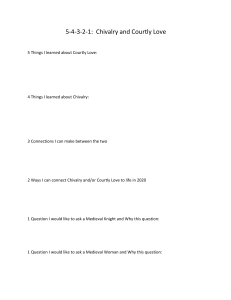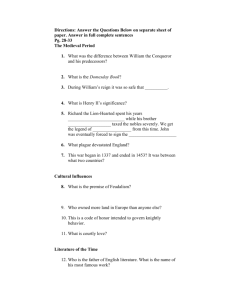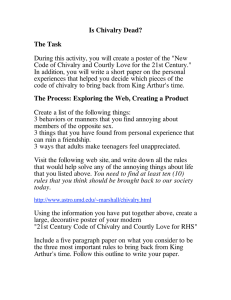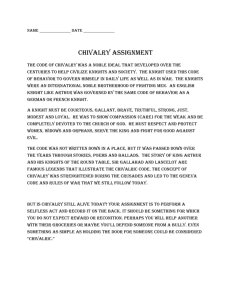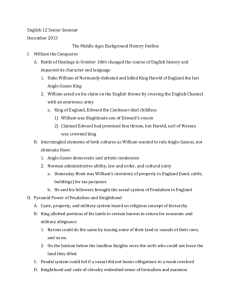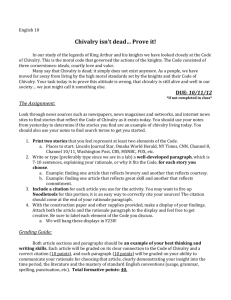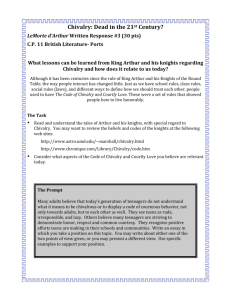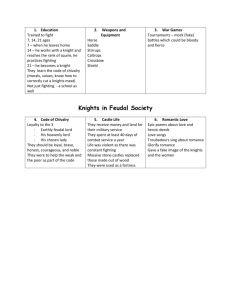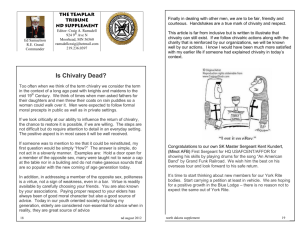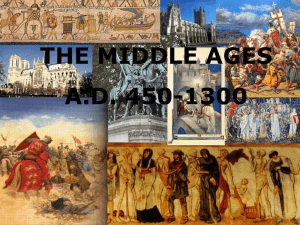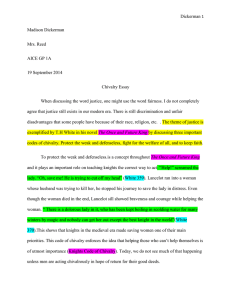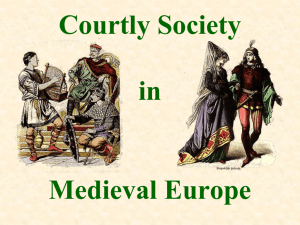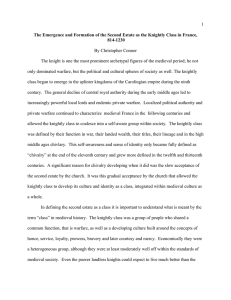Medieval Entertainment & Chivalry
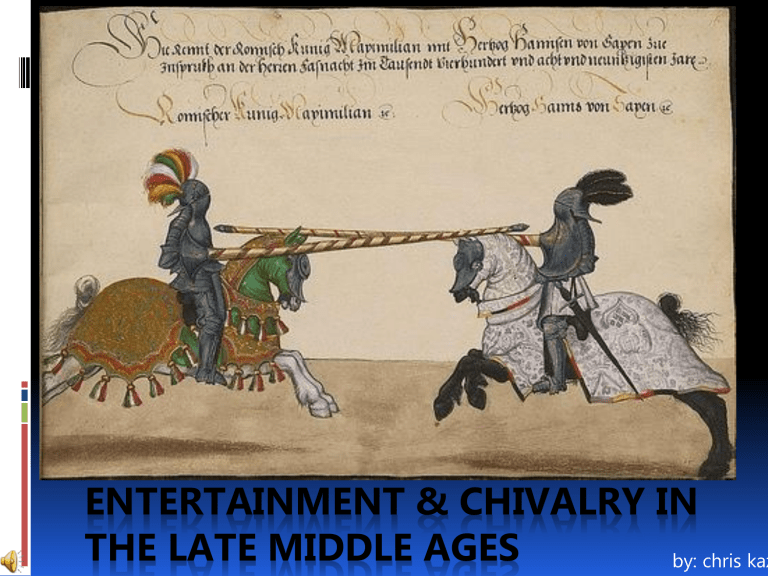
ENTERTAINMENT & CHIVALRY IN
THE LATE MIDDLE AGES
by: chris kazun
Music
Music was incorporated into almost everything feasts, fairs, tournaments, church
Songs were about chivalry; singing of the lords
(feudal lord) virtues, and his achievements.
Written and performed by traveling troubadours and minstrels
Common instruments were lyre, guitar, harp, flute, drums, horns
Music at church was different
mostly Gregorian chant
Indoor Games: Chess,
Alquerque (ancestor of
Checkers), Hazard
(ancestor of Craps),
Backgammon
Outdoor Games:
Skittles (bowling),
Archery, Horseshoes,
Quarterstaff contests,
Wrestling, Stoolball
(ancestor of Cricket or
Baseball)
Games
Feasts
Large, elaborate meal. Many people invited.
Often used to celebrate holidays and other special occasions.
Hosted by the lords in Great Hall of their castles/manors
Entertainment provided
Troubadours, minstrels, jesters, and jugglers would provide entertainment for guests between courses
Feasts Cont.
Many courses were served, each having multiple dishes.
served on best gold and silver platters cooks molded pastries into elaborate scenes.
food was decorated with edible paints
Blackbirds were sometimes hidden in pies
Each new dish was announced by trumpets and drums.
Courses at a
Feast
Began with light meats, soups/broths, moist fruits, and greens
Courses with dishes of heavier meats, fruits, and breads followed
Exotic dishes and delicacies were served in small portions – only to honoured guests
Sweets were last course
Cheese and wine was served throughout
Fairs
Gathering of buyers and sellers during specific seasons, or by special appointment, for trade.
Usually during time of a saint’s feast day around the church or abbey
except in England
fairs were held on Village Greens or open land near or within towns.
entertainment was used to attract a crowd, singers, musicians, acrobats, stilt walkers and fools. Fairs included various contests such as archery tournaments.
Mystery Plays
Plays based on stories from Bible depicted such subjects as the Creation, Adam and
Eve, the murder of Abel, the Last Judgment, and the Life of Jesus
(miracles, passion, resurrection) church clergymen were the first to present plays of this type
One of the ways in which people learned the stories of their faith
In 13 th century the subjects of plays become increasingly nonreligious guilds (masons, smiths, tanners, grocers, butchers, etc.) steadily took over presenting plays
Their characters gradually came to be a conventional set
famous figures of popular tradition (St. George and the Green Dragon, Robin
Hood, Maid Marian)
Other Plays
Animal Sports
Bear and Bull Baiting post set in the ground towards the edge of the pit and the bear or bull chained to it, either by the leg or neck. well-trained hunting dogs would then be set on it
Dogs replaced as they tired or were wounded or killed
Dog and Cock Fighting
Two roosters or dogs pitted against each other in a fight
survivor wins.
Fables
Fable: a short story containing a moral; usually feature animals as characters
Extremely popular in the courts of nobles
Many were satires of society
Marie de France was one of the most popular of authors with counts, barons and knights, but especially with ladies
Probably of Norman origin, spent most of her life in England
was connected to court of Henry II and Eleanor of Aquitaine
wrote more than 100 fables
1 st woman to write narrative verse in western vernacular
Christine de Pizan (1363 – ca.
1430)
Born in Venice
Married at 15 to a French courtier (died
10 years later)
Well educated (Latin, philosophy, literature, and sciences) as her father was a scholar and astrologer
Began her writing career to support herself and her 3 children
Doesn’t seem to have had any problem doing this; showing her works were very popular
Wrote both poems and prose
Many of her works contain arguments about equality of the sexes
Sought respect for women’s designated roles in her society
1 st Professional
Female Writer
Geoffrey Chaucer’s Canterbury Tales
Written at end of 14 th
c.
Used Middle English rather than French or Latin
Influenced by Dante, Petrarch and Boccaccio
Tells tales of 29 pilgrims traveling from London tavern to shrine of Thomas
Becket in Canterbury
The pilgrims travel together telling each other tales
One pilgrim (Harry Bailey) suggests each pilgrim tell 2 tales on way there and 2 on way back
The tale he judges to be best will get a meal at his tavern, paid for by the other pilgrims
Character are written with high amount of realism
Reflects society of the time (as well as changing societal ideas)
Including: courtly love, corruption of church officials, and importance of friends/companions, changing role/ideas about women
Published for first time in 1475; was popular almost immediately and has remained so
Tournaments
Military games given to chivalrous competitions.
Competed in by knights
Meant to keep them fit for war; also provided the excitement of war without the killing and maiming
Mock sword fights using blunted knives and swords
Large mock battles (melee) using blunted weapons
Jousting/Tilting
2 armoured knights ride their horses towards each other, holding blunted lances in attempt to knock each other of the horse.
Despite safety precautions the intense/ferocious competition led to bloodshed and animosity among combatants more often than not; death could also result
You had to be a noble to participate
Later even had to prove your bloodline
How the Joust worked
No set points system – decided at each individual tournament
Points based on quality of the strike.
Strike to chest or center of shield earned most points
Breaking a lance tip earned double points
unhorsing an opponent earned knight a victory.
Length of match varied
single pass - three passes
Code of Chivalry
The Code
Begins developing in the 12 th c. in the poetry of France
Set codes of social conduct / court etiquette
First developed in France
Required knights to act as men of honour and valour
fight fairly, treat prisoners well, etc.
Uphold and defend Christianity, and be generous to the poor and weak
Ladies were to be respected, cherished and protected
women seen as chaste and virtuous; inspiring goodness and ardent love
These values were in contrast to the way noblemen acted (multiple affairs, numerous illegitimate children)
Advent of these values of courtesy were attempt to remedy this
Remained more literary idealism than social reality
Though it did lead to a changing sense of the aristocratic ideal
Chivalry
Knightly code of conduct (way you were to behave) associated with ideals of knightly virtues, honor and courtly love
1. Duties to countrymen and fellow Christians:
this contains virtues such as mercy, courage, valor, fairness, protection of the weak and the poor, and in the servant-hood of the knight to his lord. This also brings with it the idea of being willing to give one’s life for another’s; whether he would be giving his life for a poor man or his lord.
2. Duties to God:
this would contain being faithful to God, protecting the innocent, being faithful to the church, being the champion of good against evil, being generous and obeying God above the feudal lord.
3. Duties to women:
this is probably the most familiar aspect of chivalry. This would contain what is often called courtly love (platonic), the idea that the knight is to serve a lady, and after her all other ladies. Most especially in this category is a general gentleness and graciousness to all women. Never hit a woman.
Courtly Love
Code of Chivalry coincided with ideas of courtly love expressed in literature expression of knightly worship of an ideal embodied in person of the beloved
lover was expected to serve his lady, to obey her commands, and to gratify her merest whims usually one of the assumptions of courtly love was that the lady in question was married
establishing triangular pattern of lover-lady-jealous husband
Poems and literature recommended love at a distance (love without touching / contact without contact)
Those succumbing to physical temptation often depicted as going through at least as much suffering as joy
Saw advent of ideas of romantic love
Love was presumed to exist outside marriage
Between an man and woman who aren’t married, never could be, nor did they wish to be.
Shows increased sense of individual attitude
As love is based on individual needs/emotions rather than inherited social status or political power
King Arthur
Best known piece of literature incorporating chivalry
Knights oaths are taken very seriously (their word is and should be trusted without doubt)
Looked upon as loyal and honourable, and needing to remain so
Chrétien of Troyes was integral developing the Arthurian legend in the 12 th c.
Introduced many of the characters (Gawain, Lancelot,
Percival) and made the Holy Grail a major component
Courtly love seen in love triangle involving Lancelot,
Guinevere and Arthur
Lancelot and Guinevere have affair (one time conversation)
Homework
Write a Response encompassing the following:
Why did the ideas of chivalry develop?
Is chivalry dead?
Did it ever exist in reality or was it only seen in literature and fantasy?
